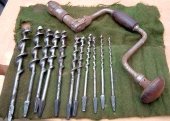
 6
6




Sourdough Without Fail Natural Small Batch Cheesemaking A Year in an Off-Grid Kitchen Backyard Dairy Goats My website @NourishingPermaculture @KateDownham






 6
6




Sourdough Without Fail Natural Small Batch Cheesemaking A Year in an Off-Grid Kitchen Backyard Dairy Goats My website @NourishingPermaculture @KateDownham






 7
7




“All good things are wild, and free.” Henry David Thoreau
 2
2




Artie Scott wrote:Hi Kate,
I use raw linseed oil. Some people consider the boiled linseed oil available at the big box stores toxic given the chemical and metallic additives they use to avoid actually boiling it - a cheaper way to get it to dry more quickly. If you can find true boiled 100% linseed oil, without the additives, the advantage over raw is it dries more quickly.
Sourdough Without Fail Natural Small Batch Cheesemaking A Year in an Off-Grid Kitchen Backyard Dairy Goats My website @NourishingPermaculture @KateDownham






 5
5




 2
2




"Where will you drive your own picket stake? Where will you choose to make your stand? Give me a threshold, a specific point at which you will finally stop running, at which you will finally fight back." (Derrick Jensen)
 9
9




 5
5




 3
3




Travis Johnson wrote:My best advice on making things last is this: "If something moves, it eventually breaks. Buy the tools that have the least moving parts.
Sourdough Without Fail Natural Small Batch Cheesemaking A Year in an Off-Grid Kitchen Backyard Dairy Goats My website @NourishingPermaculture @KateDownham






 10
10




"The only thing...more expensive than education is ignorance."~Ben Franklin. "We can easily forgive a child who is afraid of the dark; the real tragedy of life is when men are afraid of the light." ~ Plato

 7
7




- Tim's Homestead Journal - Purchase a copy of Building a Better World in Your Backyard - Purchase 6 Decks of Permaculture Cards -
- Purchase 12x Decks of Permaculture Cards - Purchase a copy of the SKIP Book - Purchase 12x copies of Building a Better World in your Backyard

 11
11




Some places need to be wild
 11
11




 7
7




 7
7




Helen Siddall-Butchers wrote:Great thread, a timely reminder for me!
I've just found my 'lost' pruning saw, and the blade has rusted (*hangs head in shame*)... can I bring it back to life? All tips gratefully received!
Learning slowly...
How permies.com works
 9
9





 8
8




My alter ego who has a potty-mouth wrote a book. Check it out here: https://www.amazon.com/Adulting-101-your-straight-succeed/dp/1732148503/ref=sr_1_5?crid=3FBIUWQCJQAPM&keywords=adulting+101&qid=1675194062&sprefix=adulting+101%2Caps%2C96&sr=8-5
 8
8




Zone 8a Handicapped Gardener with crutches, sometimes a wheelchair

 5
5




Helen Siddall-Butchers wrote:
I've just found my 'lost' pruning saw, and the blade has rusted (*hangs head in shame*)... !
Helen Siddall-Butchers wrote:
.. can I bring it back to life? All tips gratefully received!
 your wire scouring pad in the kitchen will work, along with coconut oil
your wire scouring pad in the kitchen will work, along with coconut oil


 6
6




Working toward a permaculture-strong retirement near sunny Sperling.
 5
5




 5
5




Ra Kenworth wrote:Oil items that may rust or wrap in cloth soaked in oil
I actually use clarified coconut oil myself because I can work the oil in with my bare hands
Sourdough Without Fail Natural Small Batch Cheesemaking A Year in an Off-Grid Kitchen Backyard Dairy Goats My website @NourishingPermaculture @KateDownham






 8
8




 9
9




Jay Wright wrote:If you happen to find a tool that you buried in the garden last year and it's really rusty, dilute some molasses in a can of water and drop the tool in it for a week or five. It will look like nothing's happening for a while and then all the rust will be gone- leaves metal a sandblasted looking grey colour- and yes Americans- that's the correct spelling of grey
Jay Wright wrote:For protecting hand tools- blades and wooden handles- a cheap fix is just plain old cheap margarine- doesn't stink or drip or discolour handles and you already have it in the kitchen.
 3
3




 1
1




Artie Scott wrote:Hi Kate,
I use raw linseed oil. Some people consider the boiled linseed oil available at the big box stores toxic given the chemical and metallic additives they use to avoid actually boiling it - a cheaper way to get it to dry more quickly. If you can find true boiled 100% linseed oil, without the additives, the advantage over raw is it dries more quickly.
 5
5





|
So I left, I came home, and I ate some pie. And then I read this tiny ad:
The new permaculture playing cards kickstarter is now live!
https://www.kickstarter.com/projects/paulwheaton/garden-cards
|




